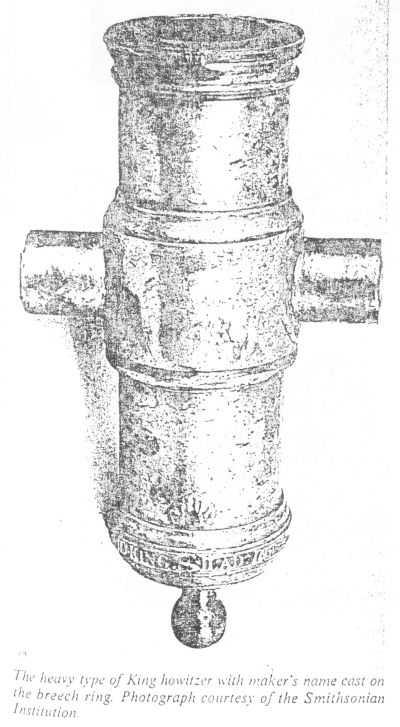 |
A month later, on 9 April, he made an entry of 30 pounds for "3000 fuses for 2 3/4" howitzers." The work was completed
by early summer, for Knox advised on 28 June that all howitzers had been forwarded. On 8 August General Wayne acknowledged
the arrival of ten of them at Hobson's Choice near Ft. Washington, and informed Secretary Knox that the damaged pieces of
the 1792 contract were being made serviceable once again by "hooping & making Iron trunnions" for them.24
After August of 1793 the subject of the howitzers disappears from the Wayne correspondence. A general inventory of military stores, however, dated 16 December 1793, shows seven 2 3/4" howitzers on hand at Philadelphia.25 Of these, two were mounted, two were dismounted, and three were damaged, probably the ones sent back during the summer of 1792. The inventory fails to account for the balance of the cannon, but does list "16 howitzer packsaddles with pillows," on hand at Ft. Washington. New tubes, carriages, and packsaddles appear to have been ready for the coming campaign. As in the case of the lighter howitzers, no details have been found concerning the new carriages. Wayne had earlier mentioned wheels, and later evidence indicates they were mounted on a small sort of field carriage;26 thus a reasonable assumption would be that the carriage was a smaller, and perhaps modified version of a regular howitzer carriage. Toussard, in 1809 illustrates a howitzer carriage in which the gun may also serve as a mortar. This is effected by having a removable board spanning two fixed transoms under the breech. With the board in place the quoin rests thereon, positioning the tube at any of the more moderate angles; removing the quoin and resting the breech on the board, the piece is elevated to 30°, and by removing the board the angle of fire then rests at 45°, allowing it to serve as a mortar.27 With the tube on in this latter position it is obvious that the under side of the barrel strikes the forward transom, which was probably ironed to prevent excessive wear, in exactly the same location where the original pieces are so deeply dented. The entire unit, tube and carriage, was intended to be loaded on single horse.28 Whether this practice was followed has not been shown. No inventories have been found revealing what items of equipment accompanied the Legion as it moved out of Greene Ville on 28 July 1794. Some historians do not concede that the list included artillery pieces, saying there was no need for artillery at Fallen Timbers, yet who could foresee in July just where or how the campaign would end. An entry, moreover, in the little known journal of Thomas Underwood, apparently a militia artillery officer, attests to the fact that artillery was used in the Fallen Timbers fight. Under the date of 20 August 1794, he wrote: "on the margin of the river, Lieutenant Percy Pope commanded Capt. John Prices company of artillery and he was the first officer that fired a shot from our howitzers. Several of the first shots was with shell then he commenced with grape and cannister shot."29 |
|
Back Next |